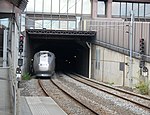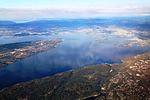Gressholmen
Islands of OsloNorway island stubsOslo geography stubs

Gressholmen is an islet located in the Oslofjord, just south of central Oslo. Administratively it belongs to the borough of Gamle Oslo. Gressholmen airport was for the years 1927 through 1939 the location of the main airport for Oslo, until the construction of Fornebu airport. The airport was only for seaplanes. The ramp with rail tracks and the hangar are reused for boat storage and maintenance. There is railway point with the big track gauge. The island is easily accessible from Oslo with the local ferries. The access point is on the North side. A big part of the island is a nature reserve.
Excerpt from the Wikipedia article Gressholmen (License: CC BY-SA 3.0, Authors, Images).Gressholmen
German Bunker, Oslo Gamle Oslo
Geographical coordinates (GPS) Address Nearby Places Show on map
Geographical coordinates (GPS)
| Latitude | Longitude |
|---|---|
| N 59.884444444444 ° | E 10.720277777778 ° |
Address
Gressholmen-Rambergøya naturreservat
German Bunker
0252 Oslo, Gamle Oslo
Norway
Open on Google Maps










